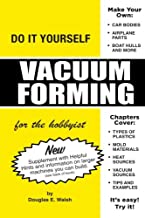Vacuum Forming for the Hobbyist / Douglas E Walsh
| List Price: | |
Our Price: $12.95 | |
|
For Bulk orders
| |
|
Used Book Price: $8.77 | |
| Vacuum Forming for the Hobbyist / Douglas E Walsh | |
| Publisher: Workshop Publishing | |
| Availability:Usually ships in 24 hours | |
| Sales Rank: 1146895 | |
|
Similar Books
Learn how to use heat and vacuum to mold flat plastic sheets into complex shapes. Build your own low cost equipment using hardware store items and your kitchen oven as a heat source. This popular book takes a common manufacturing process and boils it down to its simplest form, so it can be done right in the home. Its a fast and easy way to mold high quality plastic parts. Best of all, it requires no special skills and very little equipment. This book goes beyond vacuum cleaners as a source of suction and shows you how to get 5 times more forming power. Chapter 2 tells why heat lamps and heat guns won't work well, and shows how to use your kitchen oven and alternate heat sources Chapter 1 - The Basics The Vacuum Forming Process Vacuum Forming (also called Thermoforming), is a simple process that uses heat to soften a plastic sheet, and then vacuum to suck it down tightly against a pattern or mold. The plastic quickly cools and retains this shape. You can start with flat plastic sheets up to 1/4 inch thick and heat them in your kitchen oven. The mold can be made from wood, plaster, epoxy resin, aluminum, plastic and many other materials or built up from a combination of materials. This process makes "Shell" type parts. Some examples are: Candy Molds, Toys, Model car bodies, Model airplane parts, Boat hulls, Signs, Holiday decorations, Soap and Candy molds, Containers and packaging. Chapter 2 - Heat Sources Most plastics require between 250 and 400 degrees F. to get soft enough. We are not trying to melt the plastic, just make it soft like a sheet of rubber. Your kitchen oven was designed to heat food at these temperatures, so its a safe and convenient way to heat plastic as well. This chapter shows the differences between gas and electric ovens and how to use them effectively. Find out why heat guns and heat lamps should be avoided. Other heat sources are discussed, such as, electric frying pans and griddles, toaster ovens, hot plates etc.., with advice on using each one. Chapter 3 - Vacuum Sources A simple explanation of what vacuum is and how its measured, with charts and conversion tables. Vacuum is commonly rated in "Inches of Mercury" (IN. HG.) Most commercial vacuum forming is done with 25 -27 IN.HG. Note:Vacuum cleaners only pull 4 to 6 IN.HG. out of a possible 30 IN.HG. Even the best "Shop Vacs" don't pull very hard, they just flow a lot of air! This is barely enough to form thin plastic sheets with marginal definition. Learn how to increase that 50% by coupling two vacuum cleaners together. Seven other low cost sources of higher vacuum are discussed, such as. intake manifold vacuum (from your car), Modified bicycle pumps, air powered and electric pumps. Learn how to modify a bicycle pump to pull 27 IN.HG. and use stored vacuum form tanks. Learn how to get 5 times more forming power by combining a vacuum cleaner with another higher vacuum source to create a "two Stage" system. You won't find this information available anywhere else! Chapter 4 - Forming Equipment Picture of home built vacuum forming equipment Learn how to make a simple holding frame out of aluminum angle from the hardware store. Learn how to modify a sump pump check valve from the hardware store to combine a vacuum cleaner with a second higher vacuum source. Chapter 5 - Plastics There are a million types of plastic sheets, but only a half dozen that you are likely to come across. This chapter discusses the common types and gives you practical advice on choosing the right plastic. Chapter 6 - Molds The theme of this book is "low budget", so this chapter focuses mainly on wood and plaster molds. Learn six "common sense" rules of moldmaking, such as avoiding undercuts, surface preparation and the use of release agents. Chapter 7 - Forming Once you have the equipment built, this chapter gives you practical advice on the actual forming process. Chapter 8 - Finishing Learn three ways to trim out the finished part depending on thickness
Now you can buy Books online in USA,UK, India and more than 100 countries.
*Terms and Conditions apply
Disclaimer: All product data on this page belongs to .
.
No guarantees are made as to accuracy of prices and information.
Now you can buy Books online in USA,UK, India and more than 100 countries.
*Terms and Conditions apply
Disclaimer: All product data on this page belongs to
 .
.No guarantees are made as to accuracy of prices and information.










